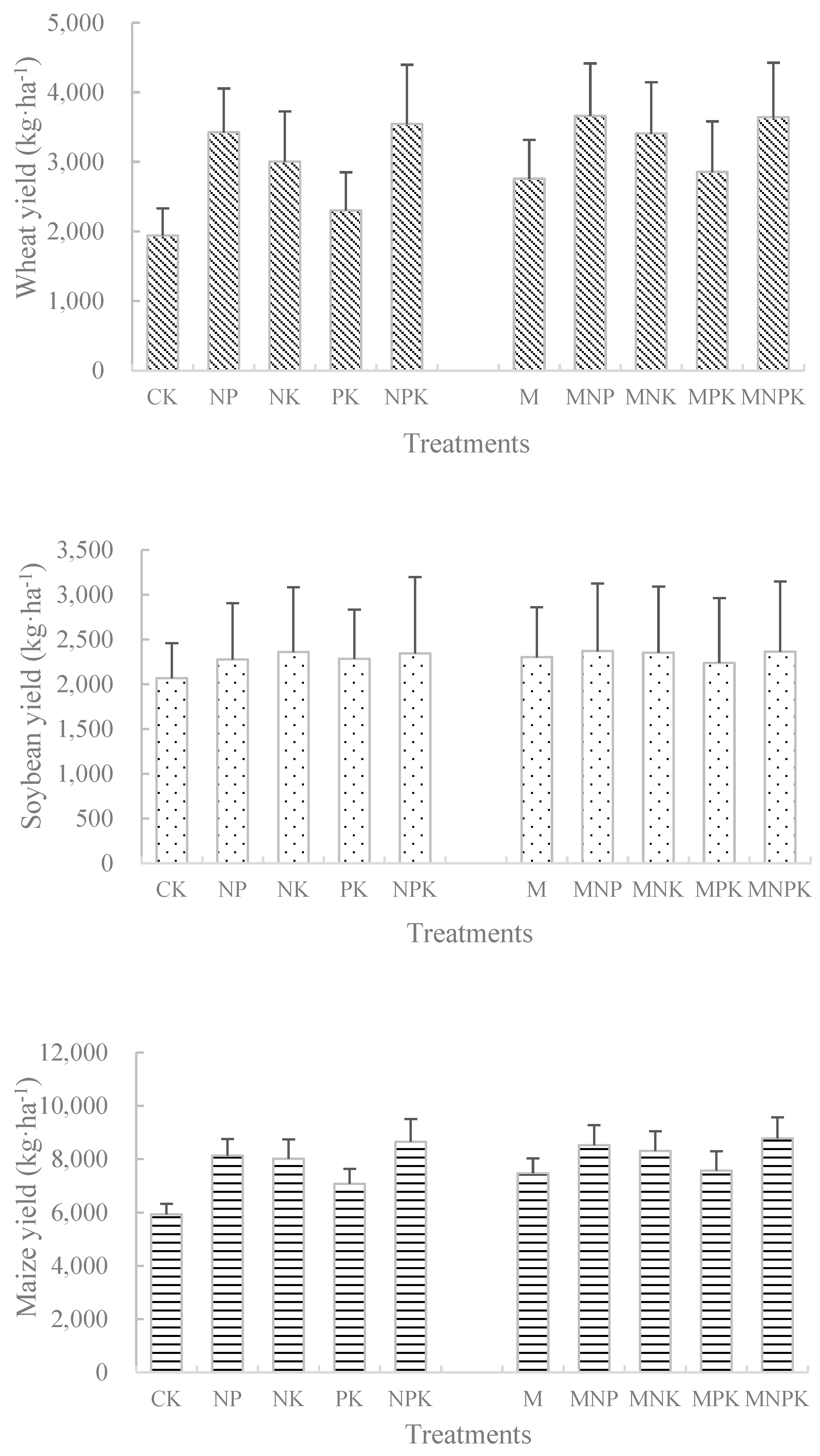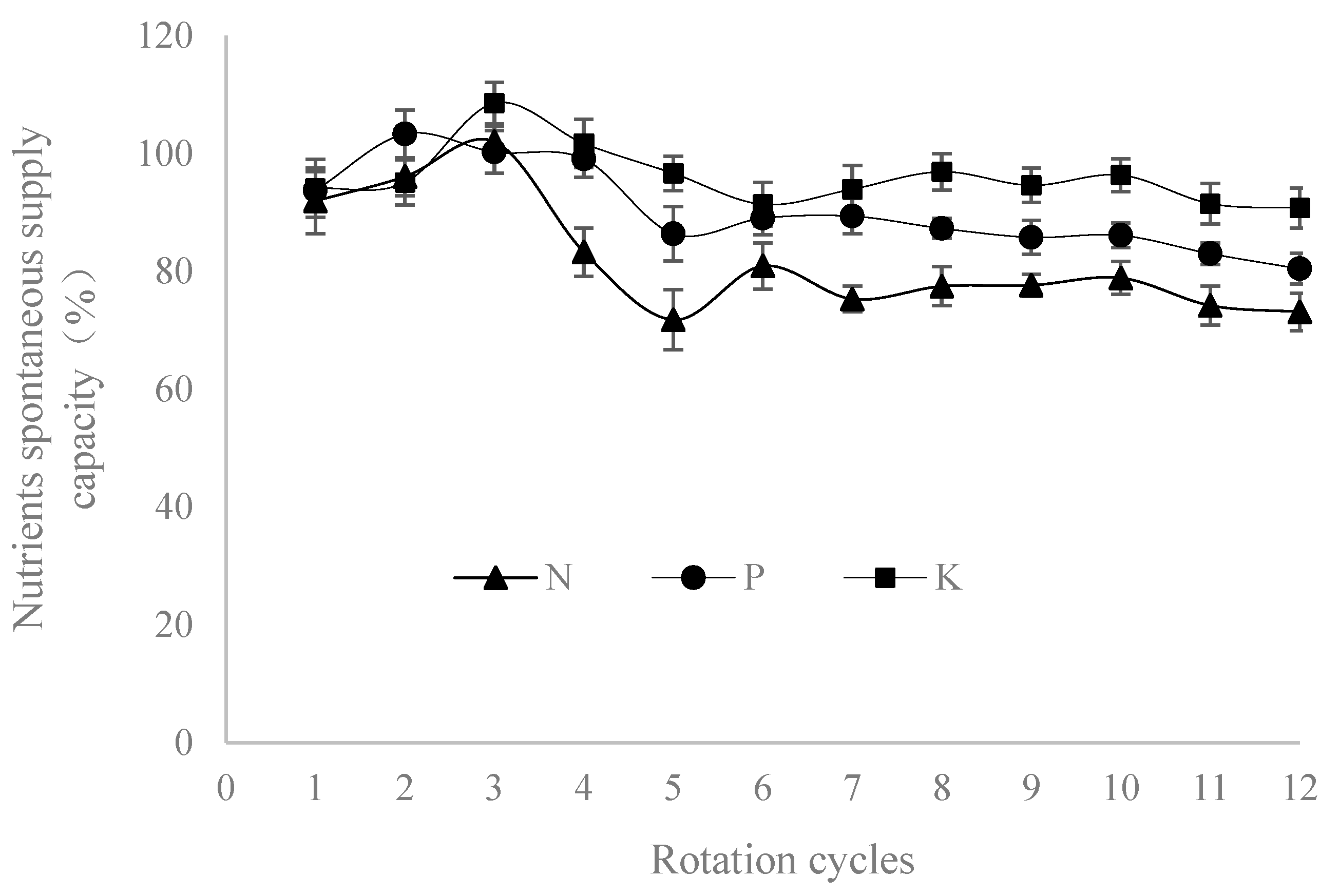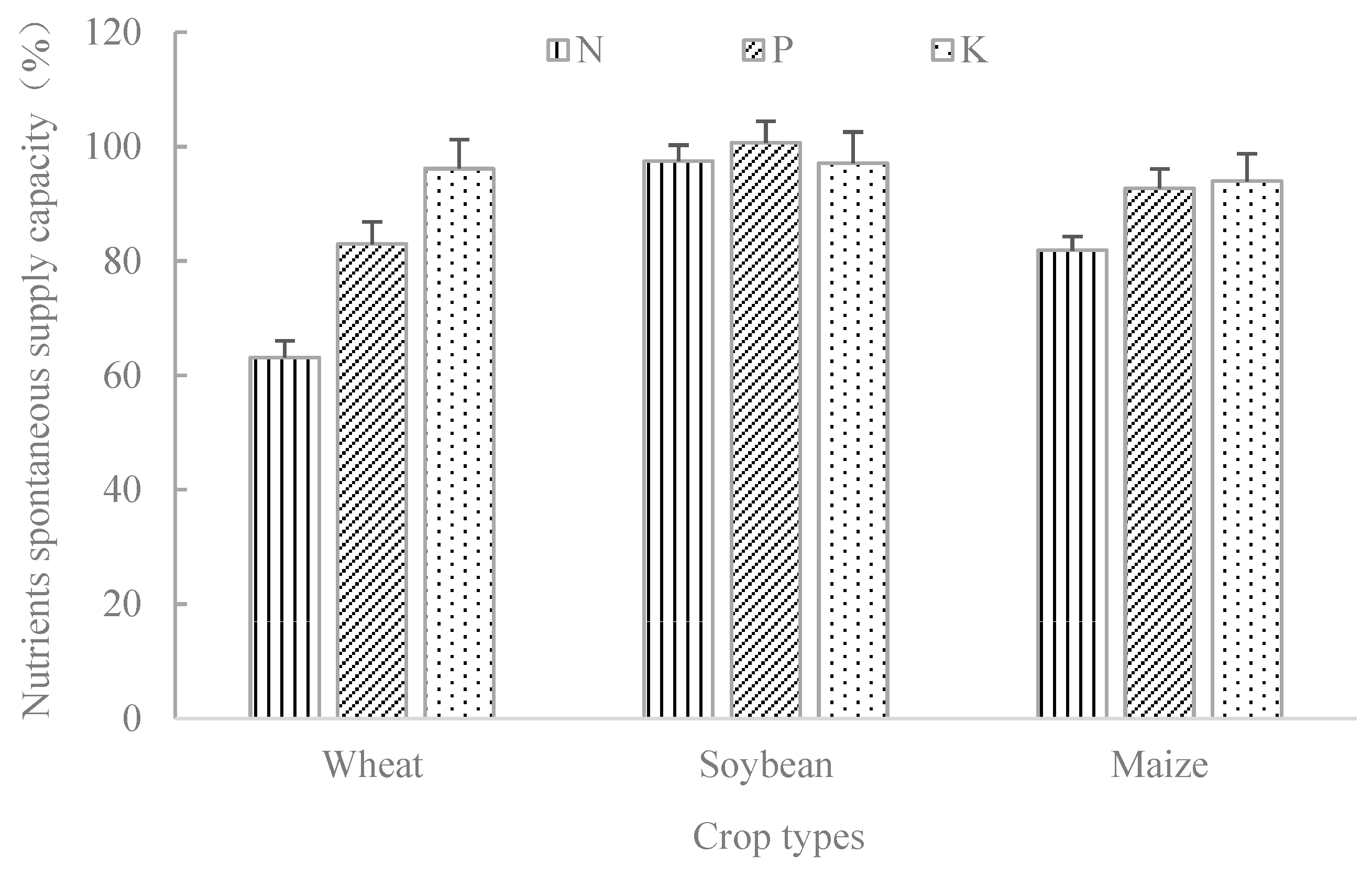Response of Crop Yield and Productivity Contribution Rate to Long-Term Different Fertilization in Northeast of China
Abstract
:1. Introduction
2. Materials and Methods
2.1. Experimental Site
2.2. Experimental Design
2.3. Calculation
2.4. Data Analyses
3. Results and Analysis
3.1. Changes in Crop Yield Under Different Fertilization Treatments
3.2. Sustainability and Stability of Crop Yield
3.3. Productivity Contribution Rate of Black Soil
3.4. Natural Nutrient Supply Capacity of Black Soil
4. Discussion
4.1. Effect of Long-Term Fertilization on Crop Yields
4.2. Effect of Long-Term Fertilization on Sustainability and Stability of Crop Yield
4.3. Productivity Contribution Rate and Natural Nutrient Supply Capacity of Black Soil
5. Conclusions
Author Contributions
Funding
Data Availability Statement
Conflicts of Interest
References
- Chaudhury, J.; Mandal, U.K.; Sharma, K.L.; Mandal, H.G.B. Assessing soil quality under long-term rice based cropping system. Commun. Soil Sci. Plant Anal. 2005, 36, 1141–1161. [Google Scholar] [CrossRef]
- Manna, M.C.; Swarup, A.; Wanjari, R.H.; Ravankar, H.N.; Mishra, B.; Saha, M.N.; Singh, Y.V.; Sahi, D.K.; Sarap, P.A. Long-term effect of fertilizer and manure application on soil organic carbon storage, soil quality and yield sustainability under sub-humid and semi-arid tropical. India Field Crops Res. 2005, 93, 264–280. [Google Scholar] [CrossRef]
- Bhattacharyya, R.; Kundu, S.; Prakash, V.; Gupta, H.S. Sustainability under combined application of mineral and organic fertilizers in a rainfed soybean-wheat system of the Indian Himalayas. Eur. J. Agron. 2008, 28, 33–46. [Google Scholar] [CrossRef]
- Liu, Z.; Qiu, X.; Liu, Y.; Fang, H.; Lin, Z.; Yang, Z.; Lin, Y.; Zhuang, S. Contribution of fertilizers to yield increase and its effect on soil organic matter. J. Plant Nutr. Fert. 1994, 1, 19–26. [Google Scholar]
- Men, X.; Li, X.; Xu, G. Effects of Long-Term Fertilization on Crop Yields and Stability. Sci. Agric. Sin. 2008, 41, 2339–2346. [Google Scholar]
- Gu, Q.; Yang, X.; Sun, B.; Ma, L.; Tong, Y.; Zhao, B.; Zhang, F. Effects of long-term fertilization on soil nutrition and land productivity in topsoil of Loess soil. Acta Agric. Borealioccident. Sin. 2004, 13, 121–125. [Google Scholar]
- Li, X.; Men, X.; Wang, S.; Qi, Y.; Xu, H. The effects of long-term fertilization on crop yields and farmland nutrient equilibrium. Acta Pratac. Sin. 2009, 18, 9–16. [Google Scholar]
- Zhang, K.; Song, X.; Guo, D.; Huang, C.; Yue, K.; Zhang, S.; Huang, S. Variation Characteristics of Soil Organic Carbon, Nitrogen and the Stability of Wheat Yield in Fluvo-Aquic Soil under Long-Term Fertilization. Acta Agric. Boreali-Sin. 2021, 36, 142–149. [Google Scholar]
- Li, J.; Zhang, L.; Zhang, M.; Wang, H.; Zhang, H.; Zhang, Y. Yield stability in peanut-sweet potato rotation system under long-term combined application of chemical and organic fertilizers in latosolic red soil. J. Plant Nutr. Fert. 2021, 27, 179–190. [Google Scholar]
- Gao, H.; Peng, C.; Zhang, X.; Li, Q.; Zhu, P. Effect of Long-Term Different Fertilization on Maize Yield Stability in the Northeast Black Soil Region. Sci. Agric. Sin. 2015, 48, 4790–4799. [Google Scholar]
- Manna, M.C.; Swarup, A.; Wanjari, R.H.; Mishra, B.; Shahi, D.K. Long-term fertilization, manure and liming effects on soil organic matter and crop yields. Soil Tillage Res. 2007, 94, 397–409. [Google Scholar] [CrossRef]
- Lu, B.; Bao, X.; Che, Z.; Zhang, J.; Wu, K.; Yang, R. Effects of long-term no-tillage with crop stubbles on yield and stability of spring wheat in Hexi Oasis Irrigated Areas. Trans. Chin. Soc. Agric. Eng. 2022, 38, 117–126. [Google Scholar]
- Ma, X.; Zhou, B.; Hao, X.; Chen, X.; Gao, Z.; Chi, F. Phosphorus balance and availability in black soil under long-term wheat−soybean−maize rotation and fertilization. J. Plant Nutr. Fert. 2018, 24, 1672–1678. [Google Scholar]
- Wang, M.; Ge, A.H.; Ma, X.; Wang, X.; Xie, Q.; Wang, L.; Song, X.; Jiang, M.; Yang, W.; Murray, J.D.; et al. Dynamic root microbiome sustains soybean productivity under unbalanced fertilization. Nat. Commun. 2024, 15, 1668. [Google Scholar] [CrossRef]
- Hao, X.; Zhou, B.; Ma, X.; Gao, Z. Characteristics of crop yield and nutrient balance under different long-term fertilization practices in black soil. Trans. Chin. Soc. Agric. Eng. 2015, 31, 178–185. [Google Scholar]
- Deng, H.; Ma, X.; Liu, Z.; Hu, H.; Di, H.J.; Liu, Y.; Shi, S.; Hao, X.; Zhao, Y.; He, J.; et al. Soil ecosystem multifunctionality is strongly linked with crop yield after four decades chemical fertilization in black soil. Agric. Ecosyst. Environ. 2024, 368, 109007. [Google Scholar] [CrossRef]
- Chauhan, S.K.; Chauhan, C.P.; Minhas, P.S. Effect of cyclic use and blending of alkali and good quality waters on soil properties, yield and quality of potato, sunflower and Sesbania. Irrig. Sci. 2007, 26, 81–89. [Google Scholar] [CrossRef]
- Kong, L.; Cao, C.; Wang, Z.; Chen, A.; Zhang, C. Effects of a long-term located fertilization and productivity of Shajiang black soil. Chin. J. Eco-Agric. 2004, 12, 102–104. [Google Scholar]
- Tirol-Padre, A.; Ladha, J.K. Integrating rice and wheat productivity trends using the SAS ixed-procedure and meta-analysis. Field Crops Res. 2006, 95, 75–88. [Google Scholar] [CrossRef]
- Gao, H.; Peng, C.; Li, Q.; Zhu, P. Influence of Long-term Fertilization on Nutrient Supplying Capacity of Black Soil and Soil Productivity. J. Maize Sci. 2010, 18, 107–110. [Google Scholar]
- Jin, X.; Yao, S.; Batbayar, J.; Jia, L.; Zhang, S.; Yang, X. Response of wheat yield and soil phosphorus fractions to long-term fertilization under rainfed winter wheat–summer fallow cropping system. J. Plant Nutr. Fert. 2018, 24, 1660–1671. [Google Scholar]
- Chen, L.; Hao, M.; Zhang, S. Effect of long-term application of fertilizer on wheat yield and fertilizer use efficiency in Loess Plateau. J. Triticeae Crops. 2006, 26, 101–105. [Google Scholar]
- Liu, Q.; Mu, X.; Wang, X.; Zhang, W.; Gao, P.; Zhao, G.; Sun, W. Effects of different long-term fertilization on crop yield and soil nutrients under rotation planting in arid region. Agric. Res. Arid Areas. 2021, 9, 122–128. [Google Scholar]
- Zhao, Y.; Xie, Y.; Hao, M. Yield effects and soil fertility evolution of long-term application of fertilizer on wheat in dry land of Loess Plateau. Acta Agric. Boreali-Occident. Sin. 2007, 16, 75–79, 88. [Google Scholar]
- E., S.; Yang, S.; Guo, Y.; Song, D.; Yang, S.; Cui, Y.; Wang, C. Effects of long-term fertilization on crop yield and indigenous soil nutrient supply in Hexi Oasis of Gansu Province. Plant Nutr. Fert. Sci. 2010, 16, 786–793. [Google Scholar]
- Dibakar, M.; Bhattacharyy, R.; Gopinath, K.A.; Tuti, M.D.; Jeevanandan, K.; Chandrashekara, C.; Arunkumar, R.; Mina, B.L.; Pandey, B.M.; Mishra, P.K.; et al. Influence of farmyard manure application and mineral fertilization on yield sustainability, carbon sequestration potential and soil property of gardenpea–french bean cropping system in the Indian Himalayas. Sci. Hortic. 2013, 164, 414–427. [Google Scholar]
- Han, T.; Li, Y.; Qu, X.; Ma, C.; Wang, H.; Huang, J.; Liu, K.; Du, J.; Zhang, L.; Liu, L.; et al. Spatio-temporal evolutions and driving factors of wheat and maize yields in China. Trans. Chin. Soc. Agric. Eng. 2022, 38, 100–108. [Google Scholar]
- Li, Z.; Xu, M.; Zhang, H.; Zhang, W. Effects of long-term different fertilizations on sustainability of maize yield in China. J. Maize Sci. 2009, 17, 82–87. [Google Scholar]
- Chen, H.; Cao, C.; Kong, L.; Zhang, C.; Li, W.; Qiao, Y.; Du, S.; Zhao, Z. Study on Wheat Yield Stability in Huaibei Lime Concretion Black Soil Area Based on Long-Term Fertilization Experiment. Sci. Agric. Sin. 2014, 47, 2580–2590. [Google Scholar]
- Yang, S.; Li, F.; Suo, D.; Guo, T.; Wang, J.; Sun, B.; Jin, S. Effect of long-term fertilization on soil productivity and nitrate accumulation in Gansu Oasis. Sci. Agric. Sin. 2005, 38, 2043–2052. [Google Scholar] [CrossRef]
- Mead, R.; Riley, J.; Dear, K.; Singh, S.P. Stability comparison of intercropping and monocropping systems. Biometrics 1986, 42, 253–266. [Google Scholar] [CrossRef]
- Horie, T.; Nakagawa, H.; Ceneno, H.G.S.; Kropff, M.J. The rice crop simulation model SIMRIW and its testing. In Modelling the Impact of Climate Change on Rice Production in Asia; Mathews, R.B., Kropff, M.J., Bachelet, D., van Larr, H.H., Eds.; CAB International and International Rice Research Institute: Los Baños, Philippines, 1995; pp. 51–66. [Google Scholar]
- Xu, M.; Liang, G.; Zhang, F. Variation of Soil Fertility in China; China Agricultural Science and Technology Press: Beijing, China, 2006. [Google Scholar]



| Treatment | Wheat | Soybean | Maize | 1 Rotation | ||||||||||
|---|---|---|---|---|---|---|---|---|---|---|---|---|---|---|
| N | P2O5 | K2O | Manure | N | P2O5 | K2O | N | P2O5 | K2O | N | P2O5 | K2O | Manure (N) | |
| CK | 0 | 0 | 0 | 0 | 0 | 0 | 0 | 0 | 0 | 0 | 0 | 0 | 0 | 0 |
| NP | 150 | 75 | 0 | 0 | 75 | 150 | 0 | 150 | 75 | 0 | 375 | 300 | 0 | 0 |
| NK | 15 | 0 | 75 | 0 | 75 | 0 | 75 | 15 | 0 | 75 | 375 | 0 | 75 | 0 |
| PK | 0 | 75 | 75 | 0 | 0 | 150 | 75 | 0 | 75 | 75 | 0 | 300 | 75 | 0 |
| NPK | 150 | 75 | 75 | 0 | 75 | 150 | 75 | 150 | 75 | 75 | 375 | 300 | 75 | 0 |
| M | 0 | 0 | 0 | 18,600 | 0 | 0 | 0 | 0 | 0 | 0 | 0 | 0 | 0 | 18,600 |
| MNP | 150 | 75 | 0 | 18,600 | 75 | 150 | 0 | 150 | 75 | 0 | 375 | 300 | 0 | 18,600 |
| MNK | 15 | 0 | 75 | 18,600 | 75 | 0 | 75 | 15 | 0 | 75 | 375 | 0 | 75 | 18,600 |
| MPK | 0 | 75 | 75 | 18,600 | 0 | 150 | 75 | 0 | 75 | 75 | 0 | 300 | 75 | 18,600 |
| MNPK | 150 | 75 | 75 | 18,600 | 75 | 150 | 75 | 150 | 75 | 75 | 375 | 300 | 75 | 18,600 |
| Treatments | Rotations 1–4 | Rotations 5–8 | Rotations 9–12 | ||||||
|---|---|---|---|---|---|---|---|---|---|
| Average Yield (kg/ha) | SYI | CV (%) | Average Yield (kg/ha) | SYI | CV (%) | Average Yield (kg/ha) | SYI | CV (%) | |
| CK | 10,354 b | 0.652 | 10.5 | 10,006 c | 0.582 | 9.1 | 8834 c | 0.363 | 15.5 |
| NP | 12,259 a | 0.813 | 5.6 | 12,824 b | 0.753 | 8.2 | 15,799 ab | 0.686 | 10.7 |
| NK | 12,180 a | 0.804 | 6.2 | 13,465 ab | 0.725 | 15.8 | 14,374 ab | 0.573 | 18.1 |
| PK | 11,438 ab | 0.775 | 3.7 | 10,672 c | 0.586 | 14.1 | 12,166 b | 0.561 | 5.3 |
| NPK | 12,300 a | 0.810 | 6.4 | 14,009 a | 0.814 | 9.2 | 17,131 ab | 0.736 | 11.6 |
| M | 11,738 a | 0.770 | 6.7 | 11,962 abc | 0.648 | 15.3 | 13,403 ab | 0.600 | 7.9 |
| MNP | 12,874 a | 0.842 | 7.0 | 13,724 a | 0.832 | 5.2 | 16,730 ab | 0.706 | 13.3 |
| MNK | 12,218 a | 0.808 | 6.0 | 13,688 a | 0.769 | 12.2 | 16,329 ab | 0.708 | 10.8 |
| MPK | 12,131 a | 0.808 | 5.3 | 12,275 abc | 0.628 | 19.9 | 13,224 ab | 0.590 | 8.3 |
| MNPK | 12,578 a | 0.849 | 4.0 | 14,115 a | 0.829 | 8.2 | 17,425 a | 0.710 | 16.2 |
| Treatments | Contribution to the Soil Productivity (%) | |||
|---|---|---|---|---|
| Rotations 1–4 | Rotations 5–8 | Rotations 9–12 | Average | |
| CK | 82.3 | 70.9 | 50.7 | 68.0 |
| NP | 97.5 | 90.9 | 90.7 | 93.0 |
| NK | 96.8 | 95.4 | 82.5 | 91.6 |
| PK | 90.9 | 75.6 | 69.8 | 78.8 |
| NPK | 97.8 | 99.2 | 98.3 | 98.4 |
| M | 93.3 | 84.7 | 76.9 | 85.0 |
| MNP | 98.4 | 97.2 | 96.0 | 97.2 |
| MNK | 97.1 | 97.0 | 93.7 | 95.9 |
| MPK | 96.5 | 87.0 | 75.9 | 86.5 |
| MNPK | 100.0 | 100.0 | 100.0 | 100.0 |
Disclaimer/Publisher’s Note: The statements, opinions and data contained in all publications are solely those of the individual author(s) and contributor(s) and not of MDPI and/or the editor(s). MDPI and/or the editor(s) disclaim responsibility for any injury to people or property resulting from any ideas, methods, instructions or products referred to in the content. |
© 2025 by the authors. Licensee MDPI, Basel, Switzerland. This article is an open access article distributed under the terms and conditions of the Creative Commons Attribution (CC BY) license (https://creativecommons.org/licenses/by/4.0/).
Share and Cite
Ma, X.; Hao, X.; Zhao, Y.; Peng, X.; Ji, J.; Liu, S.; Zheng, Y.; Sun, L.; Zhou, B. Response of Crop Yield and Productivity Contribution Rate to Long-Term Different Fertilization in Northeast of China. Plants 2025, 14, 132. https://doi.org/10.3390/plants14010132
Ma X, Hao X, Zhao Y, Peng X, Ji J, Liu S, Zheng Y, Sun L, Zhou B. Response of Crop Yield and Productivity Contribution Rate to Long-Term Different Fertilization in Northeast of China. Plants. 2025; 14(1):132. https://doi.org/10.3390/plants14010132
Chicago/Turabian StyleMa, Xingzhu, Xiaoyu Hao, Yue Zhao, Xinhua Peng, Jinghong Ji, Shuangquan Liu, Yu Zheng, Lei Sun, and Baoku Zhou. 2025. "Response of Crop Yield and Productivity Contribution Rate to Long-Term Different Fertilization in Northeast of China" Plants 14, no. 1: 132. https://doi.org/10.3390/plants14010132
APA StyleMa, X., Hao, X., Zhao, Y., Peng, X., Ji, J., Liu, S., Zheng, Y., Sun, L., & Zhou, B. (2025). Response of Crop Yield and Productivity Contribution Rate to Long-Term Different Fertilization in Northeast of China. Plants, 14(1), 132. https://doi.org/10.3390/plants14010132





